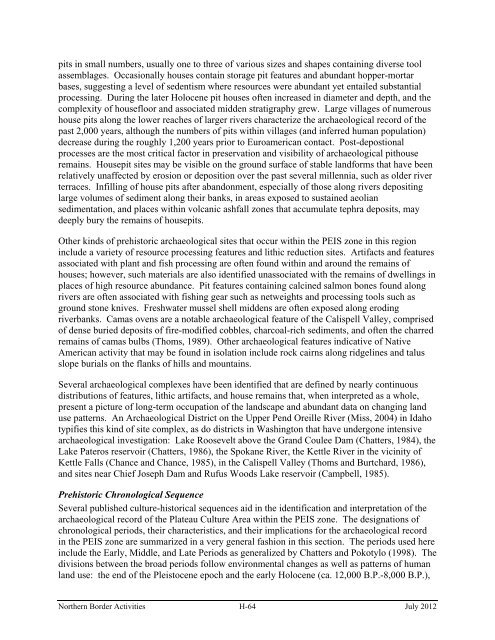Appendix H - Historical Archaeological and ... - CBP.gov
Appendix H - Historical Archaeological and ... - CBP.gov
Appendix H - Historical Archaeological and ... - CBP.gov
Create successful ePaper yourself
Turn your PDF publications into a flip-book with our unique Google optimized e-Paper software.
pits in small numbers, usually one to three of various sizes <strong>and</strong> shapes containing diverse tool<br />
assemblages. Occasionally houses contain storage pit features <strong>and</strong> abundant hopper-mortar<br />
bases, suggesting a level of sedentism where resources were abundant yet entailed substantial<br />
processing. During the later Holocene pit houses often increased in diameter <strong>and</strong> depth, <strong>and</strong> the<br />
complexity of housefloor <strong>and</strong> associated midden stratigraphy grew. Large villages of numerous<br />
house pits along the lower reaches of larger rivers characterize the archaeological record of the<br />
past 2,000 years, although the numbers of pits within villages (<strong>and</strong> inferred human population)<br />
decrease during the roughly 1,200 years prior to Euroamerican contact. Post-depostional<br />
processes are the most critical factor in preservation <strong>and</strong> visibility of archaeological pithouse<br />
remains. Housepit sites may be visible on the ground surface of stable l<strong>and</strong>forms that have been<br />
relatively unaffected by erosion or deposition over the past several millennia, such as older river<br />
terraces. Infilling of house pits after ab<strong>and</strong>onment, especially of those along rivers depositing<br />
large volumes of sediment along their banks, in areas exposed to sustained aeolian<br />
sedimentation, <strong>and</strong> places within volcanic ashfall zones that accumulate tephra deposits, may<br />
deeply bury the remains of housepits.<br />
Other kinds of prehistoric archaeological sites that occur within the PEIS zone in this region<br />
include a variety of resource processing features <strong>and</strong> lithic reduction sites. Artifacts <strong>and</strong> features<br />
associated with plant <strong>and</strong> fish processing are often found within <strong>and</strong> around the remains of<br />
houses; however, such materials are also identified unassociated with the remains of dwellings in<br />
places of high resource abundance. Pit features containing calcined salmon bones found along<br />
rivers are often associated with fishing gear such as netweights <strong>and</strong> processing tools such as<br />
ground stone knives. Freshwater mussel shell middens are often exposed along eroding<br />
riverbanks. Camas ovens are a notable archaeological feature of the Calispell Valley, comprised<br />
of dense buried deposits of fire-modified cobbles, charcoal-rich sediments, <strong>and</strong> often the charred<br />
remains of camas bulbs (Thoms, 1989). Other archaeological features indicative of Native<br />
American activity that may be found in isolation include rock cairns along ridgelines <strong>and</strong> talus<br />
slope burials on the flanks of hills <strong>and</strong> mountains.<br />
Several archaeological complexes have been identified that are defined by nearly continuous<br />
distributions of features, lithic artifacts, <strong>and</strong> house remains that, when interpreted as a whole,<br />
present a picture of long-term occupation of the l<strong>and</strong>scape <strong>and</strong> abundant data on changing l<strong>and</strong><br />
use patterns. An <strong>Archaeological</strong> District on the Upper Pend Oreille River (Miss, 2004) in Idaho<br />
typifies this kind of site complex, as do districts in Washington that have undergone intensive<br />
archaeological investigation: Lake Roosevelt above the Gr<strong>and</strong> Coulee Dam (Chatters, 1984), the<br />
Lake Pateros reservoir (Chatters, 1986), the Spokane River, the Kettle River in the vicinity of<br />
Kettle Falls (Chance <strong>and</strong> Chance, 1985), in the Calispell Valley (Thoms <strong>and</strong> Burtchard, 1986),<br />
<strong>and</strong> sites near Chief Joseph Dam <strong>and</strong> Rufus Woods Lake reservoir (Campbell, 1985).<br />
Prehistoric Chronological Sequence<br />
Several published culture-historical sequences aid in the identification <strong>and</strong> interpretation of the<br />
archaeological record of the Plateau Culture Area within the PEIS zone. The designations of<br />
chronological periods, their characteristics, <strong>and</strong> their implications for the archaeological record<br />
in the PEIS zone are summarized in a very general fashion in this section. The periods used here<br />
include the Early, Middle, <strong>and</strong> Late Periods as generalized by Chatters <strong>and</strong> Pokotylo (1998). The<br />
divisions between the broad periods follow environmental changes as well as patterns of human<br />
l<strong>and</strong> use: the end of the Pleistocene epoch <strong>and</strong> the early Holocene (ca. 12,000 B.P.-8,000 B.P.),<br />
Northern Border Activities H-64 July 2012
















